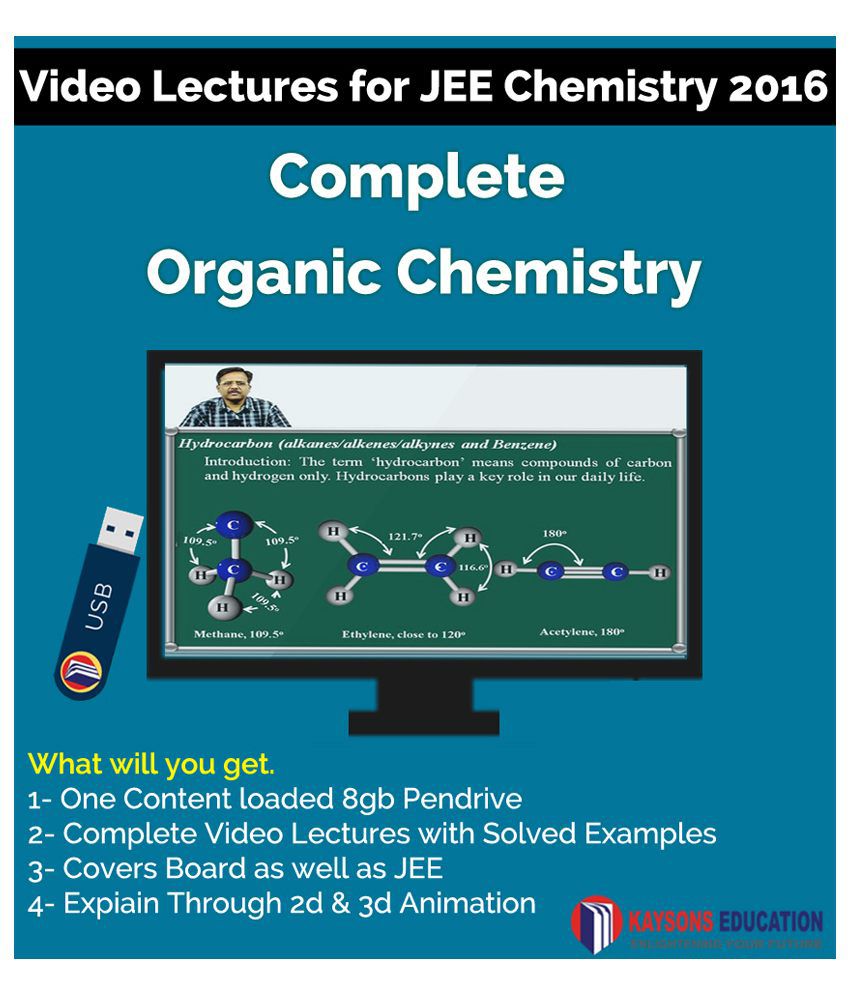Something went wrong. Please refresh the page and try again.
Something went wrong. Please refresh the page and try again.
Notifications can be turned off anytime from settings.
Item(s) Added To cart
Qty.
Something went wrong. Please refresh the page and try again.
Something went wrong. Please refresh the page and try again.
Exchange offer not applicable. New product price is lower than exchange product price
Please check the updated No Cost EMI details on the payment page
Exchange offer is not applicable with this product
Exchange Offer cannot be clubbed with Bajaj Finserv for this product
Product price & seller has been updated as per Bajaj Finserv EMI option
Please apply exchange offer again
Your item has been added to Shortlist.
View AllYour Item has been added to Shopping List
View AllSorry! Kaysons Organic Chemistry Video Lectures for JEE Mains and Advance in Pendrive/Micro Sd Card By IITians with 17 years of Exp. is sold out.


You will be notified when this product will be in stock
We will despatch the device containing course content within 72 Hrs of purchase
Short Description
Complete Syllabus for organic Chemistry Explained by IITian. 42 hours of video lectures covering 11th and 12th Board syllabus as well as JEE
Product Details
About the Teacher
Dr. Joseph Daniel ( Ph.D IIT Kanpur Experience: 15 Years)
Mr. Sudhi Raj Verma (B.Tech from IIT Kanpur and M.Tech From IIT Bombay Experience: 18 years )
Table of Content (List of Topics Covered)
Unit 3- Organic Chemistry Part I
Classification and representation of organic molecules
Representation and Nomenclature of organic molecules, What is an organic molecule?, How organic molecules are represented?, Representation of molecular structure, Can structural diagrams on a two dimensional page show there dimensional information?, Three dimensional representation, Fisher projection, Fisher projection with more than one asymmetric carbon atom, Newman projection, Sawhorse representation, Flying wedge representation, Translation of Fisher projection to Newman and Sawhorse, Why translation is required?, Advantage of Fisher projection, Advantage of Newman and Sawhorse projection, Method of Translation, Fisher projection, Eclipsed Newman projection, Eclipsed Sawhorse projection, Staggered Newman projection, Staggered Sawhorse projection.
Nomenclature of organic molecules
Nomenclature of organic molecules, How an organic molecule is named?, IUPAC Rules for Alkenes, Some of the acceptable branched alkyl groups name used in IUPAC nomenclature are, Name the compounds, Translate the following into bond – line formula, Nomenclature of unsaturated and functionalized acyclic hydrocarbon, Rules of Naming, Here sum of the numbers matters, Poly Functional Hydrocarbons, Cyclic compounds, Aromatic compounds, Polycyclic compounds, Spiro compounds, Name the compounds, Translate the following.
Determination of molecules formula
Determination of molecular formula of an organic compound, Calculation of empirical formula, Estimation of carbon and hydrogen, Estimation of Nitrogen, Estimation of halogen, Estimation of Sulphur, Estimation of Oxygen, Determination of empirical formula, Determination of molecular weight, Gram – molecular weight, Gram – molecular volume, Victor Meyers method, This is a physical method, Cryoscopic or depression of freezing point method, Silver salt method, Volumetric methods, Calculation of molecular formula.
General concepts of chemical bonding
Concepts of chemical bonding, Covalent bond, Ionic bond, Dative covalent bond, Chemical bonding in organic molecules, Sigma (σ) and Pi (π) bonding, Linear overlapping of atomic orbitals, Lateral overlapping of atomic orbitals, Relative strength of σ and π bond, Bond strength and bond order relation, Bond length and bond order relation
Hybrid orbitals and geometry of molecules
Hybridization, Sp3 Hybrid orbitals, sp2 Hybrid orbitals, sp Hybrid orbitals, Hybrid orbitals of nitrogen, Hybrid orbitals of oxygen, Molecular shape, Modified hybrid orbitals, Valence shell electron pair repulsion (VSEPR), To find the molecular shape of a molecule X Y m.
Bonding weaker than covalent bonding Bonding weaker than covalent bonding (intermolecular forces), London (Van der Waals) forces, Effect of Van der Waals force on physical properties of compounds, Dipole – dipole interaction, Effect of dipole – dipole interaction in physical properties of compounds, Hydrogen bonding, Condition of Hydrogen Bonding, Types of hydrogen bonding, Intermolecular hydrogen bonding, Intramolecular hydrogen bonding, Effect of Hydrogen bonding on some physical properties of compounds, This unusual property of water is due to intermolecular hydrogen bonding, Effect of hydrogen bonding on the physical properties of alcohols, Effect of hydrogen bonding on hydrogen halides, Effect of hydrogen bonding on amine, Effect of hydrogen bonding in acid base strength, Conjugate acid of the base.
Factors affecting the nature of covalent bonding Factors affecting the nature of covalent bond, Inductive effect, Salient features of inductive effect, Field effects, Inductomeric effect, Inductive / field effect and physical and chemical properties of molecules, Mesomeric or resonance or conjugative effect, Mechanism of electron shift, Rules of resonance, Effect of Resonance, Electromeric effect, Resonance and electromeric effect on physic- chemical properties of molecule, Difference between inductive and mesmeric effects, Hyper conjugative effect, Baker and Nathan effect, Effects of hyper conjugation, Steric crowing to resonance.
Aromaticity 1 (aromaticity of annulenes)
Aromaticity-1, The concept of aromaticity, Valence bond theory of aromaticity of benzene, According to this theory benzene is a hybrid form of I and II, Molecular orbital theory of aromaticity of benzene, Aromaticity in molecules other than benzene, Nuclear magnetic resonance study to determine aromaticity, Predicting aromatic, antiaromatic or nonaromatic in terms of energy or stability, Huck le’s rul e (4n +2 ) of aromaticity, Annulenes, [4] Annulenes, [6] Annulene, [8] Annulene, Plan ar ‘8 ’ elec tron syst e m is an ti aromaticity, [10] Annulenes, Aromatic 10 electron systems, [12] Annulene, [14] Annulene, [16] Annulene.
Aromaticity 2 (aromaticity of other compounds)
AROMATICITY 2, Charged cyclic polyenes, Cyclopropenyl cation, Cyclopropenyl carbanion, Cyclobutadiene dication and dianion, Cyclopentadiene carbanion and cation, Cycloheptatriene carbocation and anion, Cyclooctatetraene dication and dianion, Polycyclic compounds, The most contributing resonance structures of azulenes are the following, Hetrocyclic compounds, Fulvenes and metallocenes, Fullerenes, Mesionic compounds.
Isomerism (constitutional)
Isomerism, Constitutional isomers, Structural or constitutional isomerism, Skeletal or chain isomerism, Position isomerism, Ring – chain isomerism, Functional isomerism, Metamerism, Valence isomers, Tautomerism, Dyad system, Triad system, Different types of triad system tautomerism, Keto-enol tautomerism, Acid catalyzed tautomerism (Keto-enol), Base catalyzed tautomerism (Keto-enol), Phenol-Keto tautomerism, Nitroso-oxime tautomerism, Nitro - aci tautomerism, Imine-enamine tautomerism, Valence tautomerism, Comparison of tautomerism, isomerism and molecular rearrangement and resonance.
Unit-4 Organic Chemistry Part II
Basic Organic Chemistry
Introduction To Organic Chemistry, Acyclic or open chain compounds, Modern Definition of Organic Chemistry, Reasons for Large Number of Organic Compounds, Condensed and Bond-line Structural Formulas, Classification of Organic Compounds, Alicyclic or Closed Chain or Ring Compounds, Heterocyclic, Aromatic compounds, Benzenoid aromatic compounds, Homologous Series,
Nomenclature, Root ward, Primary suffix, Secondary Suffix, Primary Prefix, Secondary prefix, Nomenclature Rules – Saturated and Branched Chain, Unsaturated and Functional Groups,
Cyclic Compounds, Aromatic Compounds are Cyclic,
Isomerism, Structural Isomerism, Chain Isomerism, Functional Isomerism, Positional Isomers, Metamers, Tautomerism,
Stereo Isomerism, Wedge and Dash, Fisher Projection, Sawhorse projections, Newman Projections, Conformers of Butane C4H10, Cyclo Hexane, Geometrical Isomerism.
Optical Isomerism, Discovery of Optical Isomerism, Measuring Optical Activity, Number of Optical Isomers of an Compound, Importance of Optical Compounds
In Biochemistry, Nomenclature of Geometric Isomers (E and Z) in Case More Than Two Different Groups are Present and Optical Isomers (R and S), Isotopes, Double and Triple Bonds, Double bonds: E/Z, Chiral Carbons:- R/S, Assigning Stereocentres Using Fischer Projections,
Purification and Elemental Analysis Methods of Purification of Organic Compounds, Sublimation, Crystallisation, Distillation, Fractional Distillation, Distillation Under Reduced Pressure, Steam Distillation, Differential Extraction, Chromatography, Qualitative Analysis of Organic Compounds, Detection of Carbon and Hydrogen, Detection of other Elements, Test for Nitrogen, Quantitative Analysis, Carbon and Hydrogen,
Nitrogen, Halogens Carius Method, Sulphur, Phosphorus, Oxygen, Empirical Formula and Molecular Formula, Determination of Molecular Mass, Duma’s Method, Chemical Method,
Reaction Mechanism
Reaction Mechanism, Introduction, Carbocations, Carbanions, Nucleophiles and Electrophiles, Electron Displacement in Substance, Strength of Various Atom and Groups, Resonance.
Conditions For Resonance, Resonance Effect or Mesomeric Effect, Hyperconjugation, Electromeric Effect (E-Effect), Classification of Reactions, Strength of Acid (in General org. chemistry),
Reaction Mechanism of Different Types, Electrophilic Addition Reactions, Addition of HX to Alkene, Markownikoff’s Rule, Nucleophilic Addition Reaction, Stereochemistry of Addition Nucleophillic, Anti-Markownikoff’s Rule (Kharash Peroxide Effect), Chain-Initiating Step, Chain-Propagation Step, Chain-terminating Step, Free Radical Addition Reaction.( Is Shown Only By Hbr), Substitution Reactions,
Free Radical Reactions in Cyclic Compounds, Stereochemistry of Radical Substitution Reaction, Electrophilic Substitution Reaction (SE), Substitution Electrophillic and Addition Electrophillic, Nucleophilic Substitution Reactions, SN1 Reaction, SN2 Reaction,
Elimination Reactions, E1 (Elimination) Reaction, E1-CB (Elimination) Reaction, E2 (Elimination) Reaction,
Hydrocarbon
Hydrocarbon (Alkanes/Alkanes/Alkanes) Introduction, Classification, Physical Properties, Alkanes Preparation Natural Source – Petroleum & Natural Gas, General Oxidation/Reduction,
Chemical Properties, In case of Bromination, Oxidation, Decomposition, Isomerization, Aromatisation, Reaction With Steam, Alkenes, Isomers, Physical State, Preparation of Alkenes Dehydrohalogenation of Alkyl Halides, Hindered Base Given Hoffman Product as Major Isomers, Dehydration of Alcohols, Dehalogenation, Reduction of Alkynes,
Chemical Properties of Alkenes Addition of Hydrogen, Addition of Halogens, Addition of Halogen Acid/Hydrogen Halide, Addition of Water (H2O) (Hydration), Hydroxylation (Glycol Formation), Ozonolysis,
Alkynes, Alkynes, Chemical Properties pf Alkynes, Aromatic Hydrocarbon, Structure of Benzene, Complete Delocalization, Properties of Benzene, Dipole Moment, Electrophilic (Aromatic) Substitution Reactions,
Halogen Compounds
Introduction, Classification, Nomenclature.
Chemical Properties, Elimination, C – (I) → Sub Nucleophillic, Electron with Drawing Group,
Alcohols, Phenols and Ethers
Alcohols, Phenols and Ethers, Mono, Di, tri or Polyhydric Compounds, Allylic Alcohols, Ethers, Nomenclature, Preparation of Alcohol (A) Hydration of Alkenes, Reduction by catalytic Hydrogen, Hydrolysis of Esters, From Acid and Acid Derivatives.
Chemical Properties, Distinguish between 1° 2° and 3° Alcohols, Williamson Ether Synthesis, Oxymercuration/Demercuration in Presence of Alcohol, Auto Oxidation,
Phenol Preparation, Physical Properties, Chemical Properties.
Ketones and Aldehydes
Ketones and AldehydesCarbonyl Compounds, Structure of the Carbonyl Group, Nomenclature of ketones and Aldehydes,
Preparation of Aldehyde and Ketone, Hydroboration Oxidation, Decarboxylation of Calcium Salts of Carboxylic Acids, OXO Process, Wacker Process, Qzonolysis, Chemical Properties, Reduction of Carbonyls,
Addition Reaction (Nucleophillic), Cannizzaro Reaction, Aldol Condensation, Crossed Aldol Condensation, Claisen Condensation, Aromatic Aldehyde and Ketone, Chemical Properties, Claisen Schmitt Condensation, Knoevenagel Cond, Reformatsky Reaction,
Carboxylic Acid
Introduction, Classification, Nomenclature, IUPAC Names, Nomenclature of Dicarboxylic Acids, IUPAC Names of Dicaroboxylic Acids, Structure and Physical Properties of Carboxylic Acids, Acidity of Carboxylic Acids Measurement of Acidity,
Common Reducing Agents and Their Reactions, Some Common Reactions of Acid salts, Carboxylic Acid Derivatives Introduction, Structure and Nomenclature of Acid Derivatives Ester of Carboxylic Acids, Amides, Nitriles, Hydrolysis to an Acid, Synthesis from an Acid, Acids Halides, Acid Anhydrides, Boiling Points and Melting Points, Physical Properties, Chemical Properties.
Nitrogen Compounds
Nitrogen Compounds, UREA, Preparation, Properties Physical, Chemical, Amines
Introduction, Classification, Nomenclature, Preparation Primary Amines, Secondary Amines, Tertiary Amine, Hoffman’s Method, Physical Properties, Chemical Property, Aromatic Amine, Used in Separation of Amines, Reactions given only by 10 Amine, Reactions shown only by 20 Amines, Reactions Shown Only by 3o Amines,
Aniline Preparation, Chemical Properties, Substitution Electrophilic, Benzene Diazonium Chloride-Reaction of Diazanium Salt, Cyanides and Isocyanides, Isocyanides Preparation, Nitro Compounds, Halogenation,
Biomolecules
Introduction, Classification of Carbohydrates, Another Classification, Glucose, Fructose, Glycosidic Linkage, Disaccharides, Polysaccharides, Proteins, Amino Acids, Isoelectric Point, Structure of Proteins, Classification of Proteins, Denaturation of Proteins, Enzymes, Vitamins, Nucleic Acids, Basic Structure of Nucleic Acid, H-bonds between the nitrogenous bases in DNA, Different Types of RNA Formed in the Cell, H-bonds between the nitrogenous bases in RNA, Replication of two DNA.
Polymers
Introduction, Classification of Polymers,
Chemistry in Everyday Life
Introduction, Drugs, Different Medicines Antacids, Antihistamines, Neurologically Active Drugs, Antimicrobials, Chemicals in Food, Cleaning Agents.
Benefits:
1- Day wise Study plan 2- Ex. Teachers 3-boards as well as for JEE 4- Detail explinations and Problem solving 5- study through high quality animations
USP of the product:
1-Watch Video at home 2- 2d & 3d animations 3- detailed theory as well as problem solving
How to install micro sd card:-
Ogranic Chemistry:-
Ketones:-
Nitrogen Compounds:-
Nomenclature:-
FAQs:
Here you can have a look at our frequently asked questions. We have put together some simple answers you may have, Click here to take a look!
Learn Everything, Anywhere, Anytime
India's Largest Online Education Marketplace
The images represent actual product though color of the image and product may slightly differ.
Register now to get updates on promotions and
coupons. Or Download App